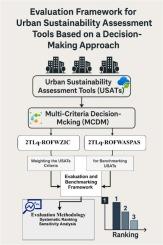基于决策方法的城市可持续性评价工具评价框架
IF 5.9
2区 工程技术
Q1 ENGINEERING, MULTIDISCIPLINARY
引用次数: 0
摘要
城市可持续性评估工具(usat)的可用性在社会中被认为是必不可少的。然而,评估usat是具有挑战性的,因为这些模型具有固有的矛盾、妥协和不同的倾向。这项研究旨在根据关键标准对usat进行基准测试。该研究解决了实践和理论的局限性,特别是权重机制的不一致性,有限的可重复性和主观判断的偏差。该研究引入了两种多标准决策(MCDM)模型:2元组语言q-Rung矫形模糊加权零不一致性(2TLq-ROFWZIC)和2元组语言q-Rung矫形模糊加权汇总和产品评估(2TLq-ROFWASPAS),从而实现更一致、可解释和可扩展的评估。2TLq-ROFWZIC确定了流动性(0.2209)和气候与能源(0.1849)的最高权重。2TLq-ROFWASPS选择BREEAM和LEED作为顶级usat,得分分别为3.4706分和3.3992分。通过七个敏感性分析场景和系统排序对方法进行了验证。这种方法提供了一种可重复的、数据驱动的决策支持工具,提高了透明度和USATs评估。本文章由计算机程序翻译,如有差异,请以英文原文为准。

Evaluation framework for urban sustainability assessment tools based on a decision-making approach
The availability of Urban Sustainability Assessment Tools (USATs) is considered essential in societies. Nevertheless, assessing USATs is challenging because inherent contradictions, compromises, and different tendencies characterise the models. This study aims to benchmark USATs against key criteria. The study addresses practical and theoretical limitations, particularly inconsistencies in weighting mechanisms, limited reproducibility, and biases in subjective judgment. The study introduces two Multi-Criteria Decision-Making (MCDM) models: 2-Tuple Linguistic q-Rung Orthopair Fuzzy Weighted Zero Inconsistency (2TLq-ROFWZIC) and 2-Tuple Linguistic q-Rung Orthopair Fuzzy Weighted Aggregated Sum Product Assessment (2TLq-ROFWASPAS), enabling more consistent, interpretable, and scalable evaluations. The 2TLq-ROFWZIC identifies the highest weights to the Mobility (0.2209) and Climate and Energy (0.1849). The 2TLq-ROFWASPS selects BREEAM and LEED as the top USATs, boasting scores of 3.4706 and 3.3992, respectively. The methodology is validated through seven sensitivity analysis scenarios and systematic ranking. This methodology delivers a reproducible, data-driven decision support tool, enhancing transparency and USATs evaluations.
求助全文
通过发布文献求助,成功后即可免费获取论文全文。
去求助
来源期刊

Ain Shams Engineering Journal
Engineering-General Engineering
CiteScore
10.80
自引率
13.30%
发文量
441
审稿时长
49 weeks
期刊介绍:
in Shams Engineering Journal is an international journal devoted to publication of peer reviewed original high-quality research papers and review papers in both traditional topics and those of emerging science and technology. Areas of both theoretical and fundamental interest as well as those concerning industrial applications, emerging instrumental techniques and those which have some practical application to an aspect of human endeavor, such as the preservation of the environment, health, waste disposal are welcome. The overall focus is on original and rigorous scientific research results which have generic significance.
Ain Shams Engineering Journal focuses upon aspects of mechanical engineering, electrical engineering, civil engineering, chemical engineering, petroleum engineering, environmental engineering, architectural and urban planning engineering. Papers in which knowledge from other disciplines is integrated with engineering are especially welcome like nanotechnology, material sciences, and computational methods as well as applied basic sciences: engineering mathematics, physics and chemistry.
 求助内容:
求助内容: 应助结果提醒方式:
应助结果提醒方式:


